Analysis of HRM Challenges in Attracting and Retaining Education Staff
VerifiedAdded on 2022/10/06
|11
|3263
|5
Essay
AI Summary
This essay examines the critical challenges of attracting and retaining a skilled workforce within the education sector. It delves into the multifaceted issues faced by human resource management in educational institutions, including poor working conditions, staffing shortages, rapid changes in educational patterns, and inadequate funding. The essay explores how these factors impact staff morale, motivation, and overall performance, leading to difficulties in recruitment and retention. It emphasizes the importance of addressing these challenges through improved salary structures, enhanced working conditions, and effective human resource management practices. The essay also highlights the significance of technological advancements and the need for continuous professional development to adapt to the evolving landscape of the education sector. Furthermore, it discusses the implementation of the AMO (Abilities, Motivation, and Opportunity) framework to improve employee performance and organizational outcomes. The essay concludes by underscoring the need for proactive human resource strategies to ensure a high-quality education system.
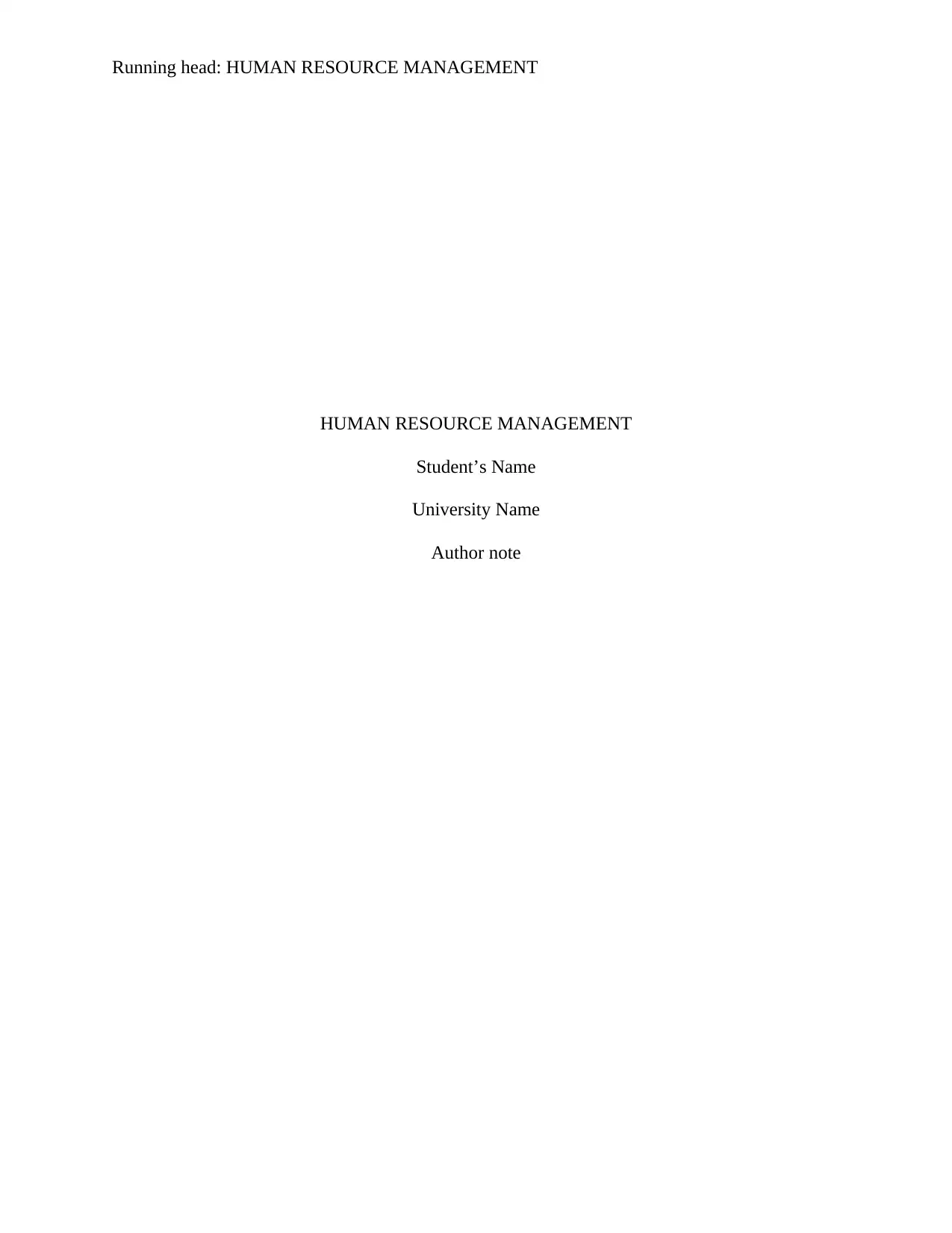
Running head: HUMAN RESOURCE MANAGEMENT
HUMAN RESOURCE MANAGEMENT
Student’s Name
University Name
Author note
HUMAN RESOURCE MANAGEMENT
Student’s Name
University Name
Author note
Paraphrase This Document
Need a fresh take? Get an instant paraphrase of this document with our AI Paraphraser
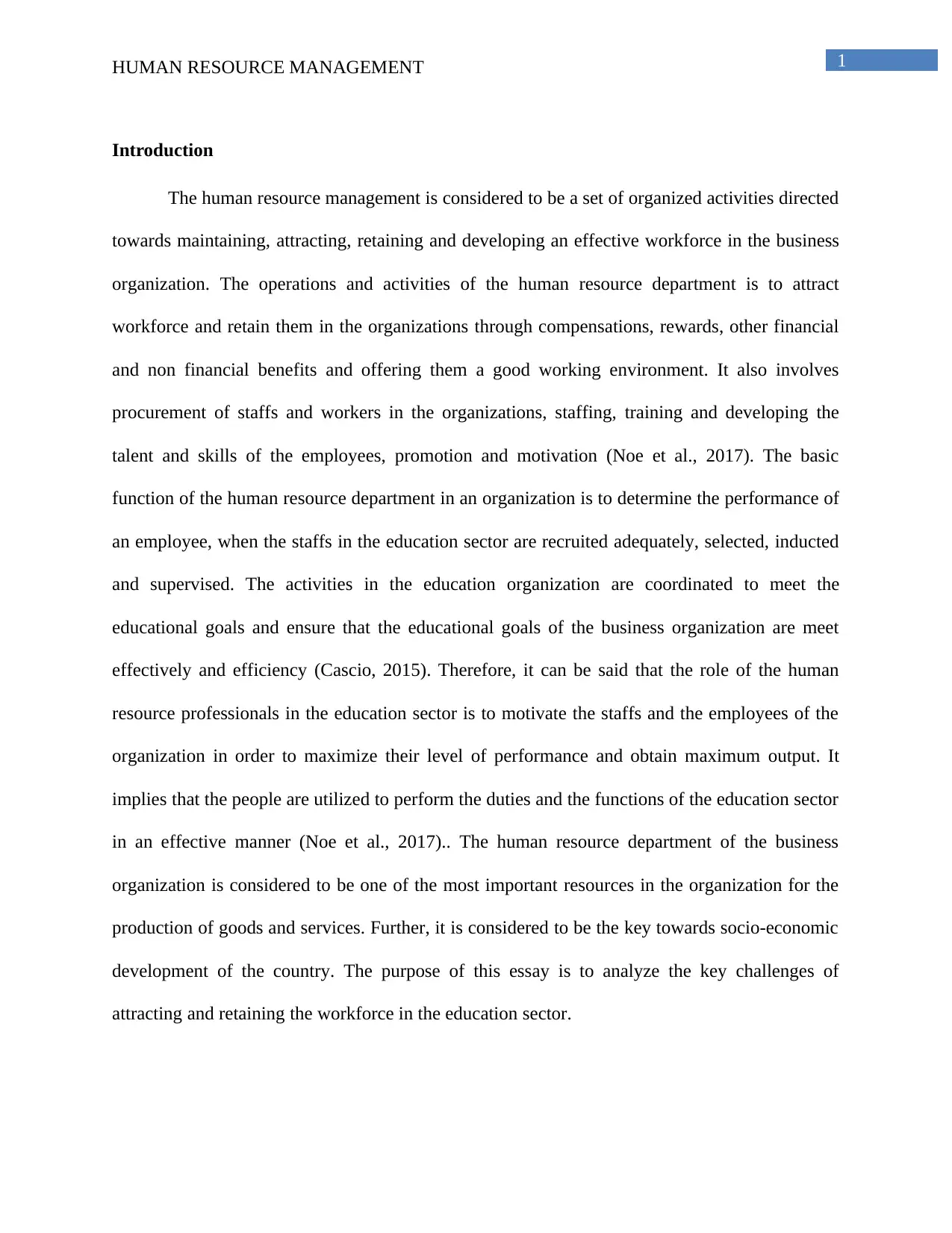
1HUMAN RESOURCE MANAGEMENT
Introduction
The human resource management is considered to be a set of organized activities directed
towards maintaining, attracting, retaining and developing an effective workforce in the business
organization. The operations and activities of the human resource department is to attract
workforce and retain them in the organizations through compensations, rewards, other financial
and non financial benefits and offering them a good working environment. It also involves
procurement of staffs and workers in the organizations, staffing, training and developing the
talent and skills of the employees, promotion and motivation (Noe et al., 2017). The basic
function of the human resource department in an organization is to determine the performance of
an employee, when the staffs in the education sector are recruited adequately, selected, inducted
and supervised. The activities in the education organization are coordinated to meet the
educational goals and ensure that the educational goals of the business organization are meet
effectively and efficiency (Cascio, 2015). Therefore, it can be said that the role of the human
resource professionals in the education sector is to motivate the staffs and the employees of the
organization in order to maximize their level of performance and obtain maximum output. It
implies that the people are utilized to perform the duties and the functions of the education sector
in an effective manner (Noe et al., 2017).. The human resource department of the business
organization is considered to be one of the most important resources in the organization for the
production of goods and services. Further, it is considered to be the key towards socio-economic
development of the country. The purpose of this essay is to analyze the key challenges of
attracting and retaining the workforce in the education sector.
Introduction
The human resource management is considered to be a set of organized activities directed
towards maintaining, attracting, retaining and developing an effective workforce in the business
organization. The operations and activities of the human resource department is to attract
workforce and retain them in the organizations through compensations, rewards, other financial
and non financial benefits and offering them a good working environment. It also involves
procurement of staffs and workers in the organizations, staffing, training and developing the
talent and skills of the employees, promotion and motivation (Noe et al., 2017). The basic
function of the human resource department in an organization is to determine the performance of
an employee, when the staffs in the education sector are recruited adequately, selected, inducted
and supervised. The activities in the education organization are coordinated to meet the
educational goals and ensure that the educational goals of the business organization are meet
effectively and efficiency (Cascio, 2015). Therefore, it can be said that the role of the human
resource professionals in the education sector is to motivate the staffs and the employees of the
organization in order to maximize their level of performance and obtain maximum output. It
implies that the people are utilized to perform the duties and the functions of the education sector
in an effective manner (Noe et al., 2017).. The human resource department of the business
organization is considered to be one of the most important resources in the organization for the
production of goods and services. Further, it is considered to be the key towards socio-economic
development of the country. The purpose of this essay is to analyze the key challenges of
attracting and retaining the workforce in the education sector.
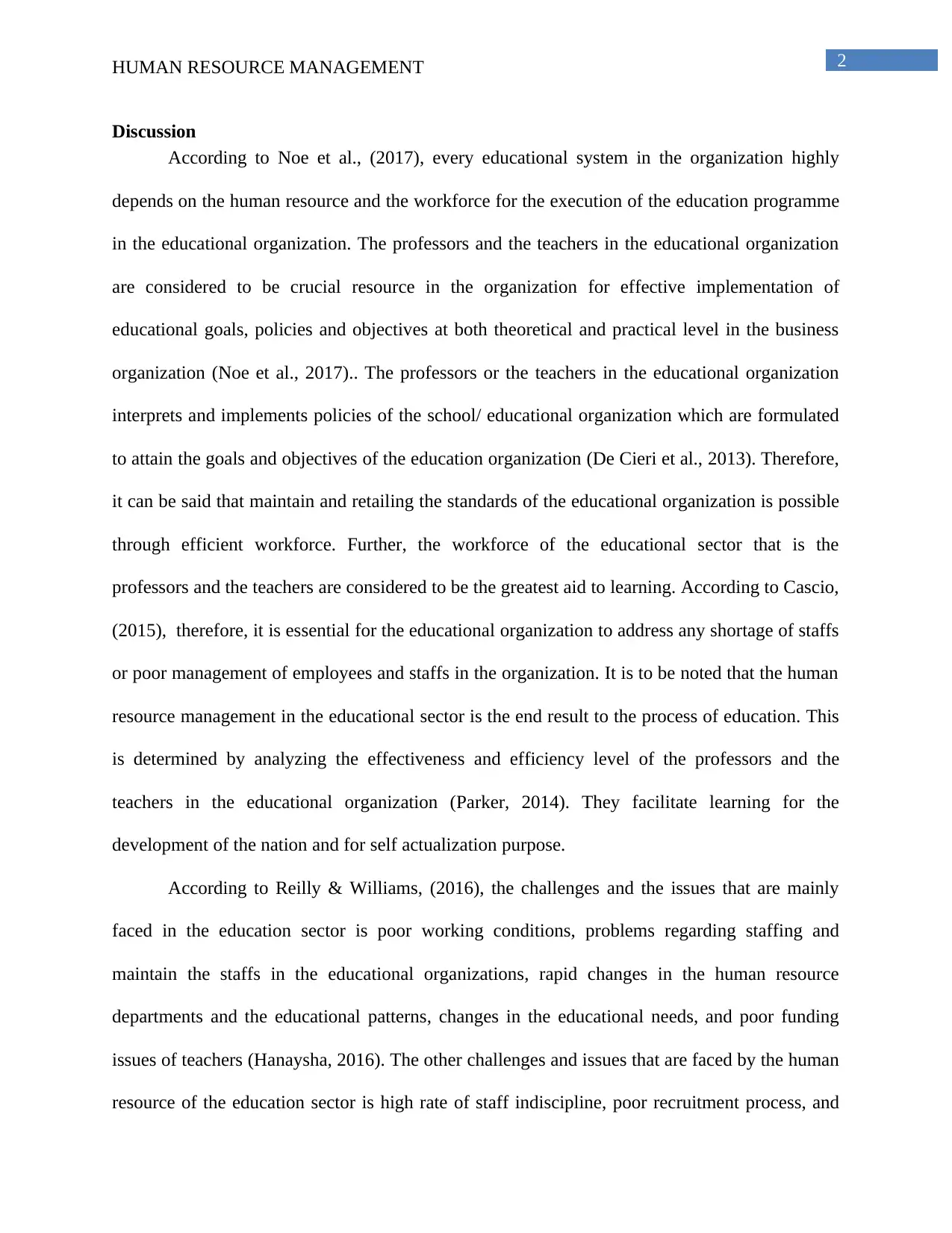
2HUMAN RESOURCE MANAGEMENT
Discussion
According to Noe et al., (2017), every educational system in the organization highly
depends on the human resource and the workforce for the execution of the education programme
in the educational organization. The professors and the teachers in the educational organization
are considered to be crucial resource in the organization for effective implementation of
educational goals, policies and objectives at both theoretical and practical level in the business
organization (Noe et al., 2017).. The professors or the teachers in the educational organization
interprets and implements policies of the school/ educational organization which are formulated
to attain the goals and objectives of the education organization (De Cieri et al., 2013). Therefore,
it can be said that maintain and retailing the standards of the educational organization is possible
through efficient workforce. Further, the workforce of the educational sector that is the
professors and the teachers are considered to be the greatest aid to learning. According to Cascio,
(2015), therefore, it is essential for the educational organization to address any shortage of staffs
or poor management of employees and staffs in the organization. It is to be noted that the human
resource management in the educational sector is the end result to the process of education. This
is determined by analyzing the effectiveness and efficiency level of the professors and the
teachers in the educational organization (Parker, 2014). They facilitate learning for the
development of the nation and for self actualization purpose.
According to Reilly & Williams, (2016), the challenges and the issues that are mainly
faced in the education sector is poor working conditions, problems regarding staffing and
maintain the staffs in the educational organizations, rapid changes in the human resource
departments and the educational patterns, changes in the educational needs, and poor funding
issues of teachers (Hanaysha, 2016). The other challenges and issues that are faced by the human
resource of the education sector is high rate of staff indiscipline, poor recruitment process, and
Discussion
According to Noe et al., (2017), every educational system in the organization highly
depends on the human resource and the workforce for the execution of the education programme
in the educational organization. The professors and the teachers in the educational organization
are considered to be crucial resource in the organization for effective implementation of
educational goals, policies and objectives at both theoretical and practical level in the business
organization (Noe et al., 2017).. The professors or the teachers in the educational organization
interprets and implements policies of the school/ educational organization which are formulated
to attain the goals and objectives of the education organization (De Cieri et al., 2013). Therefore,
it can be said that maintain and retailing the standards of the educational organization is possible
through efficient workforce. Further, the workforce of the educational sector that is the
professors and the teachers are considered to be the greatest aid to learning. According to Cascio,
(2015), therefore, it is essential for the educational organization to address any shortage of staffs
or poor management of employees and staffs in the organization. It is to be noted that the human
resource management in the educational sector is the end result to the process of education. This
is determined by analyzing the effectiveness and efficiency level of the professors and the
teachers in the educational organization (Parker, 2014). They facilitate learning for the
development of the nation and for self actualization purpose.
According to Reilly & Williams, (2016), the challenges and the issues that are mainly
faced in the education sector is poor working conditions, problems regarding staffing and
maintain the staffs in the educational organizations, rapid changes in the human resource
departments and the educational patterns, changes in the educational needs, and poor funding
issues of teachers (Hanaysha, 2016). The other challenges and issues that are faced by the human
resource of the education sector is high rate of staff indiscipline, poor recruitment process, and
⊘ This is a preview!⊘
Do you want full access?
Subscribe today to unlock all pages.

Trusted by 1+ million students worldwide

3HUMAN RESOURCE MANAGEMENT
poor personal commitment of the teachers and poor appraisal or supervision in the educational
sectors (Hunter, Saunders & Constance, 2016). It is the role and the function of the human
resource department to assessing the needs for staffs, satisfying the requirement and needs of the
employees and improving the services provided to the staffs. This will enable the organization
too effectively and efficiency manages the staffs and the employees in the education sector.
As mentioned by Parker, (2014), the employees and the staffs of the educational sector
are often pays weak salary and incentive structure. The education sector lacks sound reward
system and structure in the educational organization. This reduce equalities between the earning
do the employees and the staffs, and it thereby reduces their morale and reduce their motivation
level in the organization (Al-Abrrow & Abrishamkar, 2013). The salary structure of the
organization is not paid along side with the other civil servants. The poor working situations and
conditions in the educating sector reduce staff availability in the education sector (Cumming,
Sumsion & Wong, 2015).. Further, there are problems of staffing in the business organization.
There is inadequate availability of quality staffs or employees in the education sector. This is
considered to be the top most challenge in the education sector. In addition to inadequate
staffing, staff recruitment and selection procedure, there are political and governmental barriers
in the educational organization (Al-Abrrow & Abrishamkar, 2013). The availability of staffs and
employees in remote area is another challenge faced by the educational sector. The personal
commitment of the employees and the staffs arise from inadequate salary structure and staff
indiscipline in the education organization (Reilly & Williams, 2016).. The poor supervision and
appraisal of the employees and the staffs in this sector reduces the availability of staffs as
compared to the other sectors. Moreover, there are technological advancements and
poor personal commitment of the teachers and poor appraisal or supervision in the educational
sectors (Hunter, Saunders & Constance, 2016). It is the role and the function of the human
resource department to assessing the needs for staffs, satisfying the requirement and needs of the
employees and improving the services provided to the staffs. This will enable the organization
too effectively and efficiency manages the staffs and the employees in the education sector.
As mentioned by Parker, (2014), the employees and the staffs of the educational sector
are often pays weak salary and incentive structure. The education sector lacks sound reward
system and structure in the educational organization. This reduce equalities between the earning
do the employees and the staffs, and it thereby reduces their morale and reduce their motivation
level in the organization (Al-Abrrow & Abrishamkar, 2013). The salary structure of the
organization is not paid along side with the other civil servants. The poor working situations and
conditions in the educating sector reduce staff availability in the education sector (Cumming,
Sumsion & Wong, 2015).. Further, there are problems of staffing in the business organization.
There is inadequate availability of quality staffs or employees in the education sector. This is
considered to be the top most challenge in the education sector. In addition to inadequate
staffing, staff recruitment and selection procedure, there are political and governmental barriers
in the educational organization (Al-Abrrow & Abrishamkar, 2013). The availability of staffs and
employees in remote area is another challenge faced by the educational sector. The personal
commitment of the employees and the staffs arise from inadequate salary structure and staff
indiscipline in the education organization (Reilly & Williams, 2016).. The poor supervision and
appraisal of the employees and the staffs in this sector reduces the availability of staffs as
compared to the other sectors. Moreover, there are technological advancements and
Paraphrase This Document
Need a fresh take? Get an instant paraphrase of this document with our AI Paraphraser
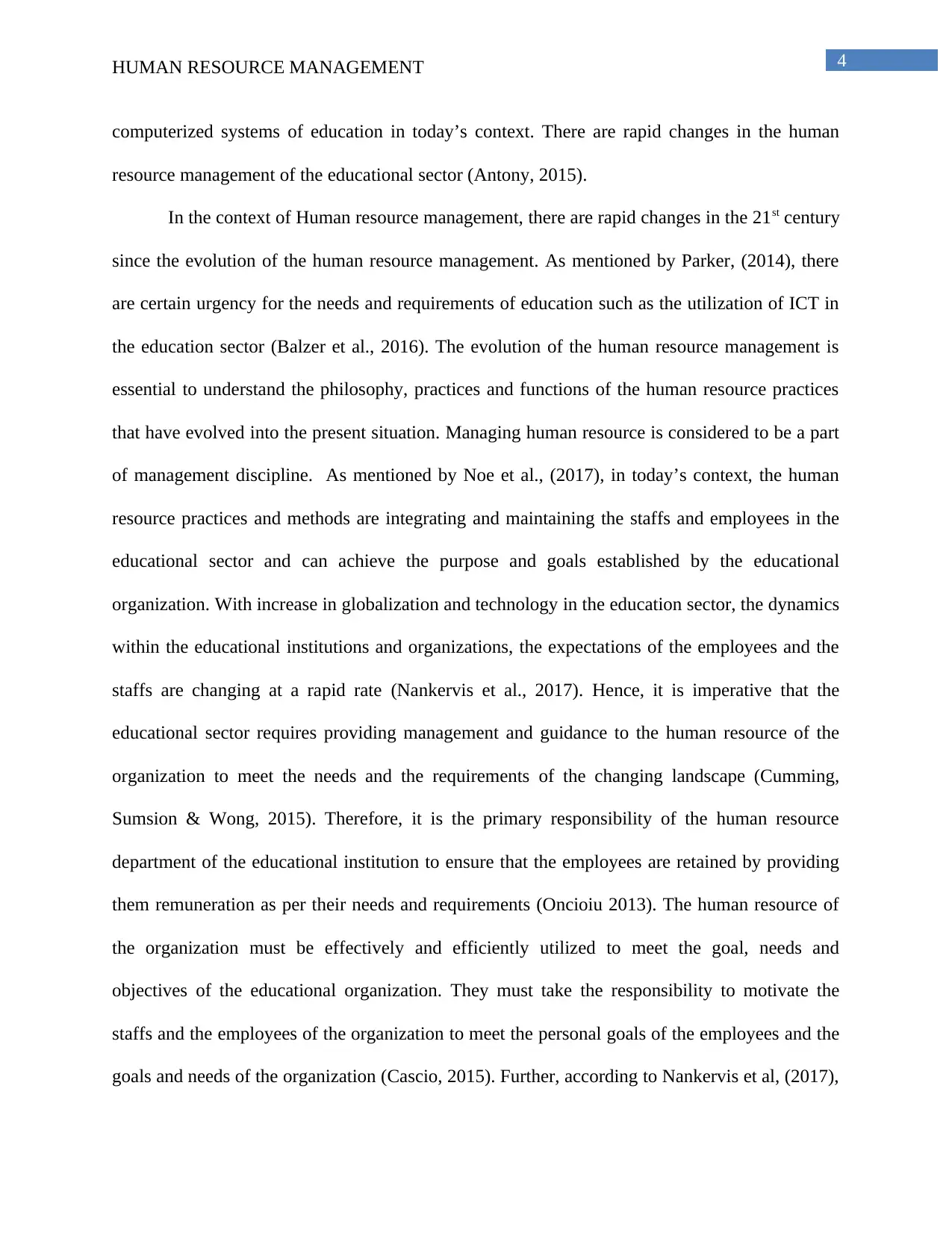
4HUMAN RESOURCE MANAGEMENT
computerized systems of education in today’s context. There are rapid changes in the human
resource management of the educational sector (Antony, 2015).
In the context of Human resource management, there are rapid changes in the 21st century
since the evolution of the human resource management. As mentioned by Parker, (2014), there
are certain urgency for the needs and requirements of education such as the utilization of ICT in
the education sector (Balzer et al., 2016). The evolution of the human resource management is
essential to understand the philosophy, practices and functions of the human resource practices
that have evolved into the present situation. Managing human resource is considered to be a part
of management discipline. As mentioned by Noe et al., (2017), in today’s context, the human
resource practices and methods are integrating and maintaining the staffs and employees in the
educational sector and can achieve the purpose and goals established by the educational
organization. With increase in globalization and technology in the education sector, the dynamics
within the educational institutions and organizations, the expectations of the employees and the
staffs are changing at a rapid rate (Nankervis et al., 2017). Hence, it is imperative that the
educational sector requires providing management and guidance to the human resource of the
organization to meet the needs and the requirements of the changing landscape (Cumming,
Sumsion & Wong, 2015). Therefore, it is the primary responsibility of the human resource
department of the educational institution to ensure that the employees are retained by providing
them remuneration as per their needs and requirements (Oncioiu 2013). The human resource of
the organization must be effectively and efficiently utilized to meet the goal, needs and
objectives of the educational organization. They must take the responsibility to motivate the
staffs and the employees of the organization to meet the personal goals of the employees and the
goals and needs of the organization (Cascio, 2015). Further, according to Nankervis et al, (2017),
computerized systems of education in today’s context. There are rapid changes in the human
resource management of the educational sector (Antony, 2015).
In the context of Human resource management, there are rapid changes in the 21st century
since the evolution of the human resource management. As mentioned by Parker, (2014), there
are certain urgency for the needs and requirements of education such as the utilization of ICT in
the education sector (Balzer et al., 2016). The evolution of the human resource management is
essential to understand the philosophy, practices and functions of the human resource practices
that have evolved into the present situation. Managing human resource is considered to be a part
of management discipline. As mentioned by Noe et al., (2017), in today’s context, the human
resource practices and methods are integrating and maintaining the staffs and employees in the
educational sector and can achieve the purpose and goals established by the educational
organization. With increase in globalization and technology in the education sector, the dynamics
within the educational institutions and organizations, the expectations of the employees and the
staffs are changing at a rapid rate (Nankervis et al., 2017). Hence, it is imperative that the
educational sector requires providing management and guidance to the human resource of the
organization to meet the needs and the requirements of the changing landscape (Cumming,
Sumsion & Wong, 2015). Therefore, it is the primary responsibility of the human resource
department of the educational institution to ensure that the employees are retained by providing
them remuneration as per their needs and requirements (Oncioiu 2013). The human resource of
the organization must be effectively and efficiently utilized to meet the goal, needs and
objectives of the educational organization. They must take the responsibility to motivate the
staffs and the employees of the organization to meet the personal goals of the employees and the
goals and needs of the organization (Cascio, 2015). Further, according to Nankervis et al, (2017),

5HUMAN RESOURCE MANAGEMENT
it is the role of the human resource department managers to maintain a human relationship and
provide favorable working environment in the organization. Due to advancement of technology,
the education sector is undergoing significant changes, as mentioned in the essay previously (De
Cieri et al., 2013). Therefore, the managers of the human resource must take initiative to develop
and implement various professional development programmers and training facilities for the
employees within the educational institutions and the organizations. They must implement
inclusive educations systems in the institutions to enhance their level of motivation and ensure
workplace commitment in the reorganizations (Reilly & Williams, 2016). The performance of
the staffs and the employees of the organization must be related closely with the performance of
the students. Advanced technology is to be incorporated in the classrooms and schools, which
enhances the efficiency of the entire educational institutions.
According to Nankervis et al, (2017), the practices of the human resource department in
the education sector involve the methods and frameworks of integrating and maintaining the
staffs and employees in the educational institutions so as to attain and achieve the purpose of
meeting the goals and objectives of the institutions (Hanaysha, 2016). It also involves motivating
and coordinating the activities and efforts of the staffs and employees in the organization by staff
maintenance by staff relations, development and training of staffs, procurement and retention of
staffs and providing rewards and compensations for job performance (Cumming, Sumsion &
Wong, 2015). The common practices of human resource management include promotional,
transfers, providing security and health services and safety in the organization. Further, the head
of the department must take initiative to ensure comfort and happiness of the staffs and the
employees working in the education organization (Al-Abrrow & Abrishamkar, 2013).
it is the role of the human resource department managers to maintain a human relationship and
provide favorable working environment in the organization. Due to advancement of technology,
the education sector is undergoing significant changes, as mentioned in the essay previously (De
Cieri et al., 2013). Therefore, the managers of the human resource must take initiative to develop
and implement various professional development programmers and training facilities for the
employees within the educational institutions and the organizations. They must implement
inclusive educations systems in the institutions to enhance their level of motivation and ensure
workplace commitment in the reorganizations (Reilly & Williams, 2016). The performance of
the staffs and the employees of the organization must be related closely with the performance of
the students. Advanced technology is to be incorporated in the classrooms and schools, which
enhances the efficiency of the entire educational institutions.
According to Nankervis et al, (2017), the practices of the human resource department in
the education sector involve the methods and frameworks of integrating and maintaining the
staffs and employees in the educational institutions so as to attain and achieve the purpose of
meeting the goals and objectives of the institutions (Hanaysha, 2016). It also involves motivating
and coordinating the activities and efforts of the staffs and employees in the organization by staff
maintenance by staff relations, development and training of staffs, procurement and retention of
staffs and providing rewards and compensations for job performance (Cumming, Sumsion &
Wong, 2015). The common practices of human resource management include promotional,
transfers, providing security and health services and safety in the organization. Further, the head
of the department must take initiative to ensure comfort and happiness of the staffs and the
employees working in the education organization (Al-Abrrow & Abrishamkar, 2013).
⊘ This is a preview!⊘
Do you want full access?
Subscribe today to unlock all pages.

Trusted by 1+ million students worldwide

6HUMAN RESOURCE MANAGEMENT
The AMO (Abilities, Motivation and Expertise) framework is implemented by the human
resource management. It is related to the single Human resource management practices such as
recruitment and selection into a professional from of development of a human resource
management system (Reilly & Williams, 2016). The AMO framework is implemented by the
human resource management to link between the operations of the management and the
performance of the educational organization. According to Noe et al., (2017), the framework
and the model suggests that the efforts of the employees can be gained by three main
components inclusion the skills and competencies of the staffs and the employees, appropriate
motivation of the employees and the staffs and the opportunity to participate. The three elements
ability, motivation and opportunity to participate are enhanced together to ensure effective
performance in the organization (Cumming, Sumsion & Wong, 2015). The human resource
practices in close relation with the education sector revolve around these three elements. The
human resource development offers ability enhancing practices such as formal training and
development which also services as an opportunity for the staffs and the employees to enhance
their abilities, skills and competencies (Antony, 2015). To enhance the motivation level of the
employees, the human resource offers career opportunities, extrinsic and intrinsic motivation
practices in the organization. The head of the department ensures high performance work
practices in the organizations through high-involvement management, innovative work practices
and installments of advanced technology in the organization (Hunter, Saunders & Constance,
2016). The practices of human resource aim to ensure a more flexible and participative work
environment in the organization. The practices also include analyzing the skills requirement in
the organization, designing the jobs to implements the skills (Reilly & Williams, 2016).. These
human resource management practices intends to enhance the performance of the education
The AMO (Abilities, Motivation and Expertise) framework is implemented by the human
resource management. It is related to the single Human resource management practices such as
recruitment and selection into a professional from of development of a human resource
management system (Reilly & Williams, 2016). The AMO framework is implemented by the
human resource management to link between the operations of the management and the
performance of the educational organization. According to Noe et al., (2017), the framework
and the model suggests that the efforts of the employees can be gained by three main
components inclusion the skills and competencies of the staffs and the employees, appropriate
motivation of the employees and the staffs and the opportunity to participate. The three elements
ability, motivation and opportunity to participate are enhanced together to ensure effective
performance in the organization (Cumming, Sumsion & Wong, 2015). The human resource
practices in close relation with the education sector revolve around these three elements. The
human resource development offers ability enhancing practices such as formal training and
development which also services as an opportunity for the staffs and the employees to enhance
their abilities, skills and competencies (Antony, 2015). To enhance the motivation level of the
employees, the human resource offers career opportunities, extrinsic and intrinsic motivation
practices in the organization. The head of the department ensures high performance work
practices in the organizations through high-involvement management, innovative work practices
and installments of advanced technology in the organization (Hunter, Saunders & Constance,
2016). The practices of human resource aim to ensure a more flexible and participative work
environment in the organization. The practices also include analyzing the skills requirement in
the organization, designing the jobs to implements the skills (Reilly & Williams, 2016).. These
human resource management practices intends to enhance the performance of the education
Paraphrase This Document
Need a fresh take? Get an instant paraphrase of this document with our AI Paraphraser

7HUMAN RESOURCE MANAGEMENT
organization and enhance the ability of the employees, increase the motivation level and provide
opportunities to contribute towards the goals and objectives of the organization (Balzer et al.,
2016).
As mentioned by Cascio, (2015), the education sector is changing rapid with the
advancement of technology and globalization. The education sector is considered to be one most
important sector in the nation. There have been technological driven changes in the process of
teaching and learning. There the HRM planning must be introduced with various forms of
innovations in order ensure a higher education system in the organization. Introduction of
technology advanced education system in the organization can provide an opportunity to the
staffs and the employees of the education sector to increase their skills and potential (Reilly &
Williams, 2016). The Human resource department needs to recruit tech savvy teachers in order
to enrich the learning and experience of the teachers (Oncioiu 2013). This planning will help the
organization to address the issues and challenges that has been identified in the education sector.
With rapid increase in the development and evolution of technology, the students are better able
to understand the theoretical concepts and better visualize at a profound level.
According to Nankervis et al, (2017), the initial process of human resource management
involves recruitment and selection. The basic goal and objective is to obtain employees and
staffs with adequate skills, talent and competencies to help the students reach their full potential.
Innovative practices must be implemented and development by the managers and the head of the
department to meet the needs and growing requirement of the educational organization. The
staffs and the employees must be provided with an induction training programs to understand the
goals and objectives of the educational institution (Hunter, Saunders & Constance, 2016).
organization and enhance the ability of the employees, increase the motivation level and provide
opportunities to contribute towards the goals and objectives of the organization (Balzer et al.,
2016).
As mentioned by Cascio, (2015), the education sector is changing rapid with the
advancement of technology and globalization. The education sector is considered to be one most
important sector in the nation. There have been technological driven changes in the process of
teaching and learning. There the HRM planning must be introduced with various forms of
innovations in order ensure a higher education system in the organization. Introduction of
technology advanced education system in the organization can provide an opportunity to the
staffs and the employees of the education sector to increase their skills and potential (Reilly &
Williams, 2016). The Human resource department needs to recruit tech savvy teachers in order
to enrich the learning and experience of the teachers (Oncioiu 2013). This planning will help the
organization to address the issues and challenges that has been identified in the education sector.
With rapid increase in the development and evolution of technology, the students are better able
to understand the theoretical concepts and better visualize at a profound level.
According to Nankervis et al, (2017), the initial process of human resource management
involves recruitment and selection. The basic goal and objective is to obtain employees and
staffs with adequate skills, talent and competencies to help the students reach their full potential.
Innovative practices must be implemented and development by the managers and the head of the
department to meet the needs and growing requirement of the educational organization. The
staffs and the employees must be provided with an induction training programs to understand the
goals and objectives of the educational institution (Hunter, Saunders & Constance, 2016).
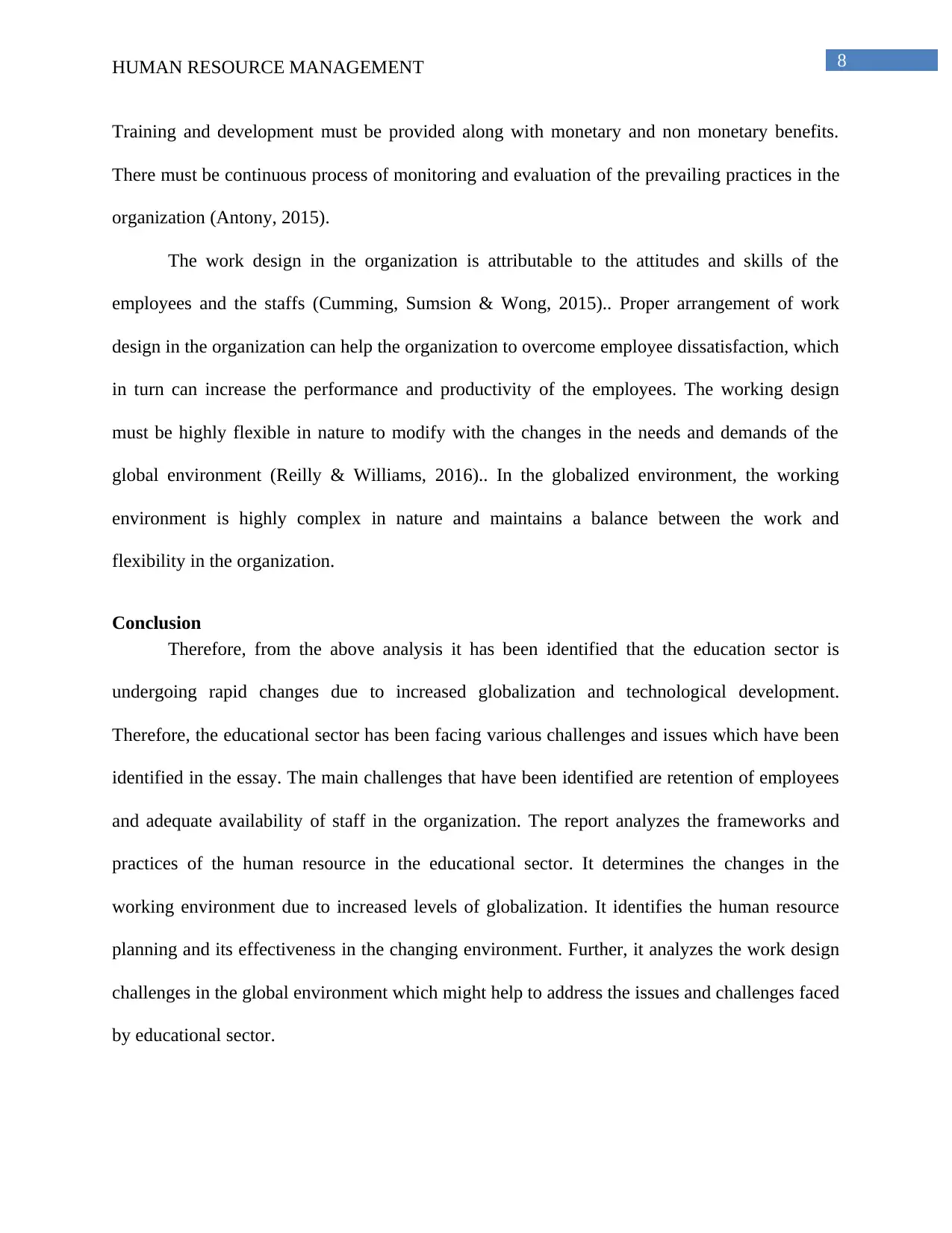
8HUMAN RESOURCE MANAGEMENT
Training and development must be provided along with monetary and non monetary benefits.
There must be continuous process of monitoring and evaluation of the prevailing practices in the
organization (Antony, 2015).
The work design in the organization is attributable to the attitudes and skills of the
employees and the staffs (Cumming, Sumsion & Wong, 2015).. Proper arrangement of work
design in the organization can help the organization to overcome employee dissatisfaction, which
in turn can increase the performance and productivity of the employees. The working design
must be highly flexible in nature to modify with the changes in the needs and demands of the
global environment (Reilly & Williams, 2016).. In the globalized environment, the working
environment is highly complex in nature and maintains a balance between the work and
flexibility in the organization.
Conclusion
Therefore, from the above analysis it has been identified that the education sector is
undergoing rapid changes due to increased globalization and technological development.
Therefore, the educational sector has been facing various challenges and issues which have been
identified in the essay. The main challenges that have been identified are retention of employees
and adequate availability of staff in the organization. The report analyzes the frameworks and
practices of the human resource in the educational sector. It determines the changes in the
working environment due to increased levels of globalization. It identifies the human resource
planning and its effectiveness in the changing environment. Further, it analyzes the work design
challenges in the global environment which might help to address the issues and challenges faced
by educational sector.
Training and development must be provided along with monetary and non monetary benefits.
There must be continuous process of monitoring and evaluation of the prevailing practices in the
organization (Antony, 2015).
The work design in the organization is attributable to the attitudes and skills of the
employees and the staffs (Cumming, Sumsion & Wong, 2015).. Proper arrangement of work
design in the organization can help the organization to overcome employee dissatisfaction, which
in turn can increase the performance and productivity of the employees. The working design
must be highly flexible in nature to modify with the changes in the needs and demands of the
global environment (Reilly & Williams, 2016).. In the globalized environment, the working
environment is highly complex in nature and maintains a balance between the work and
flexibility in the organization.
Conclusion
Therefore, from the above analysis it has been identified that the education sector is
undergoing rapid changes due to increased globalization and technological development.
Therefore, the educational sector has been facing various challenges and issues which have been
identified in the essay. The main challenges that have been identified are retention of employees
and adequate availability of staff in the organization. The report analyzes the frameworks and
practices of the human resource in the educational sector. It determines the changes in the
working environment due to increased levels of globalization. It identifies the human resource
planning and its effectiveness in the changing environment. Further, it analyzes the work design
challenges in the global environment which might help to address the issues and challenges faced
by educational sector.
⊘ This is a preview!⊘
Do you want full access?
Subscribe today to unlock all pages.

Trusted by 1+ million students worldwide
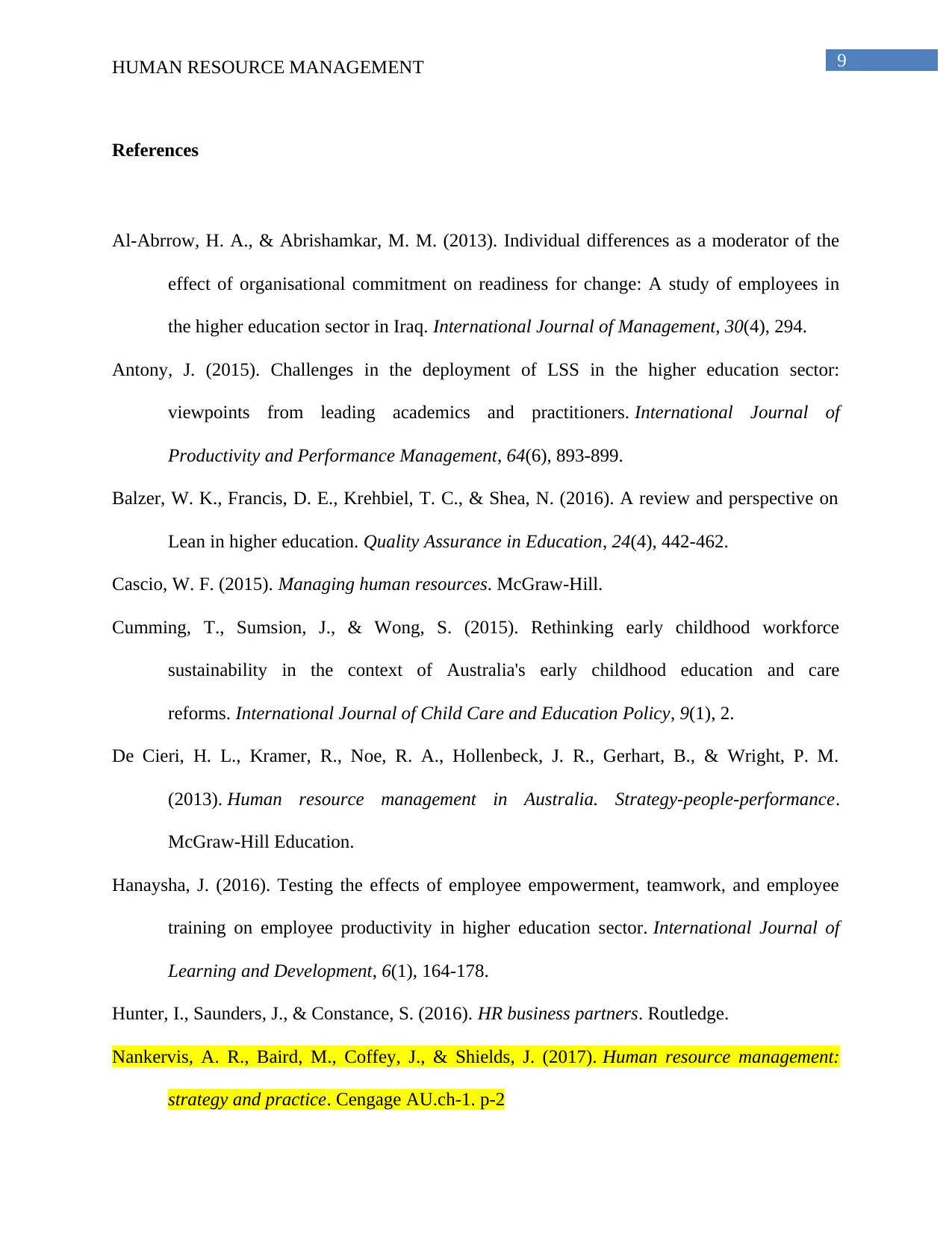
9HUMAN RESOURCE MANAGEMENT
References
Al-Abrrow, H. A., & Abrishamkar, M. M. (2013). Individual differences as a moderator of the
effect of organisational commitment on readiness for change: A study of employees in
the higher education sector in Iraq. International Journal of Management, 30(4), 294.
Antony, J. (2015). Challenges in the deployment of LSS in the higher education sector:
viewpoints from leading academics and practitioners. International Journal of
Productivity and Performance Management, 64(6), 893-899.
Balzer, W. K., Francis, D. E., Krehbiel, T. C., & Shea, N. (2016). A review and perspective on
Lean in higher education. Quality Assurance in Education, 24(4), 442-462.
Cascio, W. F. (2015). Managing human resources. McGraw-Hill.
Cumming, T., Sumsion, J., & Wong, S. (2015). Rethinking early childhood workforce
sustainability in the context of Australia's early childhood education and care
reforms. International Journal of Child Care and Education Policy, 9(1), 2.
De Cieri, H. L., Kramer, R., Noe, R. A., Hollenbeck, J. R., Gerhart, B., & Wright, P. M.
(2013). Human resource management in Australia. Strategy-people-performance.
McGraw-Hill Education.
Hanaysha, J. (2016). Testing the effects of employee empowerment, teamwork, and employee
training on employee productivity in higher education sector. International Journal of
Learning and Development, 6(1), 164-178.
Hunter, I., Saunders, J., & Constance, S. (2016). HR business partners. Routledge.
Nankervis, A. R., Baird, M., Coffey, J., & Shields, J. (2017). Human resource management:
strategy and practice. Cengage AU.ch-1. p-2
References
Al-Abrrow, H. A., & Abrishamkar, M. M. (2013). Individual differences as a moderator of the
effect of organisational commitment on readiness for change: A study of employees in
the higher education sector in Iraq. International Journal of Management, 30(4), 294.
Antony, J. (2015). Challenges in the deployment of LSS in the higher education sector:
viewpoints from leading academics and practitioners. International Journal of
Productivity and Performance Management, 64(6), 893-899.
Balzer, W. K., Francis, D. E., Krehbiel, T. C., & Shea, N. (2016). A review and perspective on
Lean in higher education. Quality Assurance in Education, 24(4), 442-462.
Cascio, W. F. (2015). Managing human resources. McGraw-Hill.
Cumming, T., Sumsion, J., & Wong, S. (2015). Rethinking early childhood workforce
sustainability in the context of Australia's early childhood education and care
reforms. International Journal of Child Care and Education Policy, 9(1), 2.
De Cieri, H. L., Kramer, R., Noe, R. A., Hollenbeck, J. R., Gerhart, B., & Wright, P. M.
(2013). Human resource management in Australia. Strategy-people-performance.
McGraw-Hill Education.
Hanaysha, J. (2016). Testing the effects of employee empowerment, teamwork, and employee
training on employee productivity in higher education sector. International Journal of
Learning and Development, 6(1), 164-178.
Hunter, I., Saunders, J., & Constance, S. (2016). HR business partners. Routledge.
Nankervis, A. R., Baird, M., Coffey, J., & Shields, J. (2017). Human resource management:
strategy and practice. Cengage AU.ch-1. p-2
Paraphrase This Document
Need a fresh take? Get an instant paraphrase of this document with our AI Paraphraser

10HUMAN RESOURCE MANAGEMENT
Nankervis, A., Compton, R., Baird, M., & Coffee, J. (2017). Human resource management:
strategy and practice. Ch-2. p-54
Nankervis, A., Compton, R., Baird, M., & Coffee, J. (2017). Human resource management:
strategy and practice.ch-5.p-178-180
Noe, R. A., Hollenbeck, J. R., Gerhart, B., & Wright, P. M. (2017). Human resource
management: Gaining a competitive advantage. New York, NY: McGraw-Hill
Education.
Oncioiu, I. (Ed.). (2013). Business innovation, development, and advancement in the digital
economy. IGI Global.
Parker, S. K. (2014). Beyond motivation: Job and work design for development, health,
ambidexterity, and more. Annual review of psychology, 65, 661-691.
Reilly, P., & Williams, T. (2016). Strategic HR: Building the capability to deliver. Routledge.
Nankervis, A., Compton, R., Baird, M., & Coffee, J. (2017). Human resource management:
strategy and practice. Ch-2. p-54
Nankervis, A., Compton, R., Baird, M., & Coffee, J. (2017). Human resource management:
strategy and practice.ch-5.p-178-180
Noe, R. A., Hollenbeck, J. R., Gerhart, B., & Wright, P. M. (2017). Human resource
management: Gaining a competitive advantage. New York, NY: McGraw-Hill
Education.
Oncioiu, I. (Ed.). (2013). Business innovation, development, and advancement in the digital
economy. IGI Global.
Parker, S. K. (2014). Beyond motivation: Job and work design for development, health,
ambidexterity, and more. Annual review of psychology, 65, 661-691.
Reilly, P., & Williams, T. (2016). Strategic HR: Building the capability to deliver. Routledge.
1 out of 11
Related Documents
Your All-in-One AI-Powered Toolkit for Academic Success.
+13062052269
info@desklib.com
Available 24*7 on WhatsApp / Email
![[object Object]](/_next/static/media/star-bottom.7253800d.svg)
Unlock your academic potential
Copyright © 2020–2025 A2Z Services. All Rights Reserved. Developed and managed by ZUCOL.


